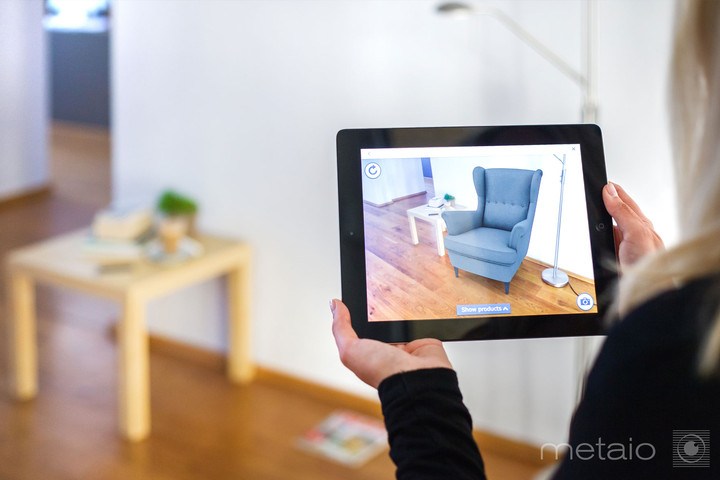Facebook has recently upped the ante in terms of their ads. Music to the ears of many Facebook users and avid online shoppers, Facebook’s newly introduced ad format uses augmented reality.
You may have already noticed Michael Kors, Wayfair and Sephora AR ads as you scroll through your newsfeed; these are just some of the first few brands that have already teamed up with Facebook to blend the real and the virtual through your smartphones and devices.
Created specifically to allow users to try on virtual versions of certain advertised products, not only can you sample items displayed such as makeup products and clothing accessories, but you can even check out how a piece of furniture will look in your own home.
That’s right, simply hold your camera up to the space that you’d like to incorporate your future coffee table in to, and you’re good to go.
But… what exactly is this augmented reality we speak of?
Augmented reality, or AR as its often referred to in the digital tech world, overlays virtual objects on to the real-world environment.
Ring any bells?
Snapchat users we’re looking at you. If you’ve dabbled with the dog filter for a Snapchat selfie in your time, then you’ve used AR without even realising. The ever evolving and extremely popular technology pioneered by apps such as Snapchat has since been adopted by huge platforms like Apple, Google and most recently, Facebook.
AR is also extremely present in the gaming world. Take the Pokémon Go game for example. The bestselling augmented reality game is played by millions of people all over the globe and allows its users to see and interact with the real world whilst vivid, digital content is added to it.
The game allows you to search for virtual creatures in real locations around you. We’re talking local parks and train stations. Top tip: If you want to catch ‘em all, don’t move quickly and be as quiet as you can – the Pokémon creatures are known to potentially get too scared and run away. No, seriously. Specific headsets for the more serious AR fanatics are even available for gaming purposes now, where detailed content is displayed in front of a user’s eye.
Travel from Australia to the land of Pikachu in one hot minute. Yes 90’s babies, dreams really do come true.
Back to Facebook ads! Why should you be using Augmented reality ads to advertise your brand?
For starters, AR ads are fun, new, and that little bit different. It makes advertising an interactive experience, as it allows advertisers and fellow marketers to connect directly to their consumers in a totally different way to any other form of advertising.
Augmented reality ads provide the option of virtual try-ons, without having to step away from the couch, your phone, or your Facebook newsfeed for that matter. No commute to store necessary.
Now, what does this mean for your brand?
Boosting sales, that’s for sure.
AR ads are certainly a significant tool for driving sales and increasing revenue, as they are a core way for customers to engage with your brand, through trying out different products. Jess Jacobs, Marketing Director at e-commerce homeware company Wayfair stated, “We see AR as great way to move the customer through the funnel, when she’s probably deciding between a couple of different things and wants to see how does this couch fit my space or how does this lamp fit on my bedside table?”
That’s right, as the little angel on your shoulder urges you to physically try on the sunglasses in your online basket before you check out, the little red devil on the other shoulder (formerly known as Facebook augmented ads), strive to totally eliminate that problem. In terms of buying directly through Facebook, the digital gurus are apparently in talks with various agencies to discuss the possibility of AR commerce, where specified AR ads will take consumers on their journey directly through to online checkout.
A consumer/brand connection is always good news.
An emotional, and somewhat personal connection built between customers and a brand is important in terms of advertising, brand awareness and encouraging purchases. Slightly similar to the experience of playing an interactive video game, AR ads provide users with a positive and fun experience of the brand they’re trialling out.
It’s fair to say that consumers are more likely to remember the brands that they’ve actually had an enjoyable experience with, rather than a standard banner advert they scroll past. Not only are AR ads a great tool for encouraging sales, but also for building a positive reputation for a company.
Hyperlocal advertising
In order to recommend suitable products and services to the right audience, Advanced machine learning algorithms are used throughout these digital ads to analyse user behaviour and interests. Smart idea. When you’re presented with the chance to try on your favourite pair of sunnies you’ve been eyeing up, why wouldn’t you?
Augmented reality ads offer marketers advanced hyperlocal advertising, as they are completely immersive and show objects directly on your smartphone’s screen. Gone are the days of simply being informed of places you could be interested in, it’s 2018 and your smartphone is now able to guide you there as well.
So what now?
Well, we did a little digging and found that data on Statista shows that the spend on AR advertising reached almost $13 billion USD in 2017, in comparison to the under $1 billion spent back in 2014. HUGE difference, right?
It’s clear that Augmented Reality advertising delivers an engaging experience, in terms of the interactive elements that the technology provides. If you want to stand out to your consumers and outperform your competitors, AR is certainly a way to do just that.
The only way is up for AR, it seems.



